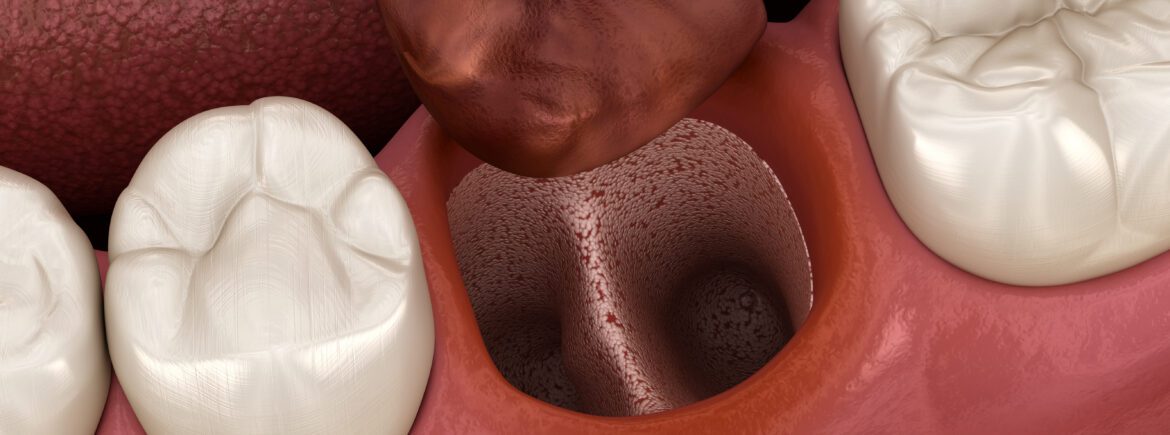Dry Socket
Dealing with a tooth extraction can be a straightforward process, but sometimes complications like a dry socket may arise, causing significant discomfort. While not everyone will encounter this issue, being informed about what a dry socket is and how it manifests can significantly aid in ensuring a smoother recovery. Today, our Perth dentist will provide you with the necessary care and guidance throughout your recovery journey. This article delves into the causes, symptoms, risk factors, and available treatment options for dry socket to arm you with the knowledge you need for a comfortable and effective healing process.

What Is a Dry Socket?
Have you ever had a tooth removal? If so, you know there’s a hole left behind, which we often call a tooth socket. Now, after the tooth has been removed, our body has a unique way of healing. Just like when you get a cut on your skin, a blood clot forms in the socket. This clot is essential; it acts as a protective barrier, covering the exposed bone and nerve endings, ensuring everything stays safe and heals properly.
But sometimes, things go differently than planned. Imagine the discomfort when something disrupts this recovery process! That’s where the dry socket comes into the picture. Technically known as alveolar osteitis, a dry socket happens when the protective blood clot is lost too early or doesn’t form the way it should. When this occurs, the bone and nerve in the socket are exposed, leading to severe pain.
Now, not everyone will develop dry socket after a tooth removal. But understanding what it is and how our body naturally heals can make all the difference in ensuring a smooth recovery.
Causes of a Dry Socket
While tooth extraction is a common procedure many people undergo, complications can arise. One of the most discomforting issues is developing dry socket or alveolar osteitis. But what causes this?
Trauma During Tooth Extraction
Sometimes, if a tooth extracted is deeply rooted or impacted, the extraction procedure might be a bit challenging. Any trauma during this process, especially in cases of a difficult tooth extraction, can increase the chances of dry socket. It’s always important to follow the advice of your South Perth dentist or oral surgeon to minimise complications.
Blood Clot Issues
The formation of a blood clot in the empty tooth socket is a crucial step for healing after having a tooth removed. However, two primary problems can arise:
Inadequate Blood Clot Formation: Sometimes, the body’s blood clotting mechanism might not work effectively, leaving the underlying bone and nerves exposed.
Premature Loss of the Blood Clot: Accidentally dislodging or dissolving the blood clot can lead to an unprotected socket, worsening pain.
Bacterial Contamination
The mouth naturally houses many bacteria. Any bacterial infection entering the tooth socket after the extraction can interfere with healing. The risk increases if one doesn’t maintain good oral hygiene after getting a tooth removed.
Tobacco and Smoking
Smoking or using tobacco products soon after an extraction can be problematic. The chemicals in tobacco can inhibit healing, and the physical act of smoking might dislodge the blood clot, leaving the socket empty and painful.
Certain Hormonal Factors
Believe it or not, even hormones play a role in this! Women on birth control pills might have a slightly elevated risk of developing dry sockets. It’s believed that some hormonal changes can interfere with the healing process of the socket.
FYI: Some medications, especially those that affect blood clotting, might also increase the risk of dry sockets. Similarly, certain medical conditions, like immune deficiencies, can make healing more challenging.
Patients who have previously developed a dry socket with past extractions may be at a higher risk of experiencing it again.
Symptoms of Dry Socket
After a tooth extraction, everyone expects a recovery period. But if you develop dry socket, the healing process becomes more challenging. So, how do you know if you’re dealing with this complication? Here are the tell-tale signs:
Intense Pain: One of the most prominent signs is severe pain that becomes evident a few days after the extraction. It isn’t your typical soreness – it’s an intense pain that makes you wince. The discomfort, often described as dry socket pain, radiates from the exposed socket where the tooth once was.
Visible Bone: When you peer into your mouth, instead of a dark blood clot covering the extraction site, you might see the stark white of the underlying bone. This visual cue indicates that the protective clot is missing.
Unpleasant Smell and Taste: A distinctive unpleasant odour, often described as bad breath, can emanate from the mouth. It isn’t your average morning breath; it’s more pronounced. Accompanying this is an unpleasant taste, making eating or drinking a less than enjoyable experience.
Swelling: Dry sockets can cause inflammation, leading to swollen lymph nodes around the neck and jaw area. It can sometimes be mistaken for other symptoms, so paying close attention is essential.
Fever: While less common, some people with a dry socket may also develop a mild fever. Monitoring this is crucial, as a persistent high temperature could indicate an infection.
If you experience any of these symptoms, you must promptly contact a dentist or oral surgeon.
Risk Factors for a Dry Socket
While tooth extraction is routine for many, not everyone experiences a smooth recovery. Some individuals face complications like alveolar osteitis or a dry socket. But why do some people get it while others don’t? Here are the risk factors that can heighten the chances:
Smoking or Tobacco Use: Lighting up a cigarette or using tobacco products after tooth removal is a big no-no. Nicotine can reduce blood flow to the area, slowing down the healing. Plus, the act of smoking can dislodge the clot from the socket.
Poor Oral Hygiene: Not maintaining a clean mouth can invite unwanted complications. Leftover food particles and bacteria can lead to infections, disrupting the clot’s stability. So, after an extraction, it’s crucial to keep the area—and your other teeth—clean.
Previous History of Dry Socket: If you’ve had alveolar osteitis before, you’re at an increased risk of facing it again. It’s essential to communicate your dental history with your dentist so they can take preventive measures.
Use of Oral Contraceptives: Surprisingly, women who use birth control pills can have a slightly higher chance of developing a dry socket. Some believe that hormones can play a role in how our body reacts post-extraction.
Wisdom Tooth Extraction: The removal of wisdom teeth, especially those in the lower jaw, can be more complex than other teeth. This complexity might elevate the chances of complications and, subsequently, pain.

Treatment for Dry Socket
Experiencing pain after a tooth extraction can be concerning. If you suspect you have a dry socket, prompt treatment at a dentist’s office is crucial. The approach to healing dry socket focuses on alleviating discomfort and ensuring proper healing.
Medical Treatment For Dry Socket
Flushing out the Socket: Keeping the surgical site clean is essential. The dentist’s instructions might include gently flushing out the empty socket to remove any debris that can impede the immune system from healing.
Medicated Dressings: A medicated dressing can be placed inside the socket. Not only does this dressing shield the affected area, but it also contains medicinal properties to ease pain and reduce inflammation. You might be asked to come back to the clinic for its replacement.
Pain Management: A dry socket can hurt, but there are ways to counteract the discomfort. Over-the-counter pain relievers and prescribed medications from the oral surgery specialist can help manage the pain. Additionally, cold packs applied to the same side of your face as the extraction can offer relief.
Antibiotics: If there’s a risk of bone infection or an infection is already present, antibiotics will be prescribed. Taking the full course is essential to ensure the infection is fully treated.
Home Remedies For Dry Socket
Salt Water Rinse: A warm salt water rinse can be beneficial for proper care of the extraction site. It gently cleans the socket and soothes the area. However, remember to avoid carbonated beverages to prevent any irritation.
Clove Oil: This age-old remedy is known for its natural pain relief properties. Applying a small amount of clove oil to the affected area can provide relief, but always follow the dentist’s instructions and be cautious not to use too much.
Post-Tooth Extraction Care to Prevent Dry Socket
A smooth recovery after a tooth extraction is ideal. Following proper post-extraction care is crucial to ensure that you don’t encounter complications like dry sockets. Here’s a comprehensive guide:
Immediate Aftercare
Straws Are Not Your Friend: As tempting as it might be to sip a smoothie or cold drink through a straw, it’s best to avoid it. The suction motion from straws can dislodge blood clots.
Say No to Tobacco: Whether it’s smoking or using other tobacco products, refrain. Tobacco can inhibit healing and increase your risk of complications.
Hands Off the Site: It might be intriguing to feel the area where your tooth once was, but resist the urge. Touching or poking the extraction site can disturb the clot and delay healing.
Dietary Recommendations
Opt for Soft Foods: In the initial days post-extraction, stick to only soft foods. This approach minimises the risk of any accidental pressure on the healing socket. Parents should seek guidance from a paediatric dentist for a child-friendly soft food diet. A pediatric dentist can provide recommendations that not only aid in healing but also ensure proper nutrition for the child during this recovery phase.
Steer Clear of Spicy Foods: Avoid hot or spicy dishes while your mouth is healing. They have the potential to dissolve or displace the clot.
Oral Hygiene
Rinse, But Gently: A gentle rinse with warm salt water or a prescription rinse can cleanse the area, especially after meals. However, avoid vigorous rinsing or brushing near the extraction site to prevent dry socket.
Activity
Take It Easy: For the first 24-48 hours, limit physical activities. Strenuous activity can elevate blood pressure, which might dislodge the protective clot.
Spit Softly: If you need to spit, do it gently. Forceful spitting can unintentionally disrupt the healing process.
Stay Hydrated
Water Is Key: Keep those tissues hydrated and support healing by drinking plenty of water throughout the day.
Frequently Asked Questions
How is dry socket treated?
Treatment typically involves cleaning the socket, removing debris, and applying a medicated dressing to protect the area and alleviate pain. Pain relief medication may also be prescribed.
Can dry socket be prevented?
Preventative measures include avoiding smoking before and after the extraction, following good oral hygiene practices, avoiding the use of straws, and following the dentist’s post-operative care instructions.
When should I see a dentist for dry socket?
If you experience severe pain a few days after a tooth extraction, or if over-the-counter pain medications are not effective, you should visit your dentist. Early treatment can help prevent further complications and alleviate the pain.
How long does it take for a dry socket to heal?
Dry socket typically begins to feel better within a few days of treatment, but complete healing can take up to two weeks. Regular follow-up appointments with a dentist can help ensure that the socket is healing properly.
Are there any specific foods to avoid with a dry socket?
Yes, to aid healing and avoid further irritation or infection, it’s advised to avoid crunchy, hard, spicy, and acidic foods. Soft foods like yogurt, applesauce, and soup are generally recommended until the area has healed.
Can dry socket lead to other complications?
If untreated, dry socket can lead to delayed healing of the extraction site, infection in the socket, and possible spread of infection to adjacent teeth or bone.

When to See a Dentist or Oral Surgeon at Acts Dental
If pain after an extraction doesn’t subside or worsens, it’s a potential sign you suspect dry socket. At Acts Dental, we emphasise the importance of seeking prompt attention to avoid complications.
Beyond handling urgent dental issues, we offer a comprehensive range of services including professional wisdom tooth removal in Perth, teeth whitening, emergency dental care, check-up and clean, and so much more, ensuring all your dental needs are met in one place.
Acts Dental is a Bupa-preferred provider, HCF-preferred provider, Medibank-preferred provider, HBF-preferred provider, and Nib-preferred provider dentist in Perth.
Your well-being is our top priority. Here’s how to reach a dentist or oral surgeon at Acts Dental: (08) 9474 5083; you can also book online.


